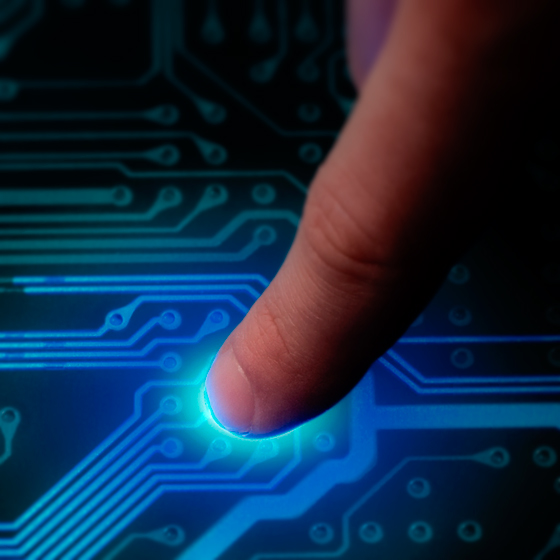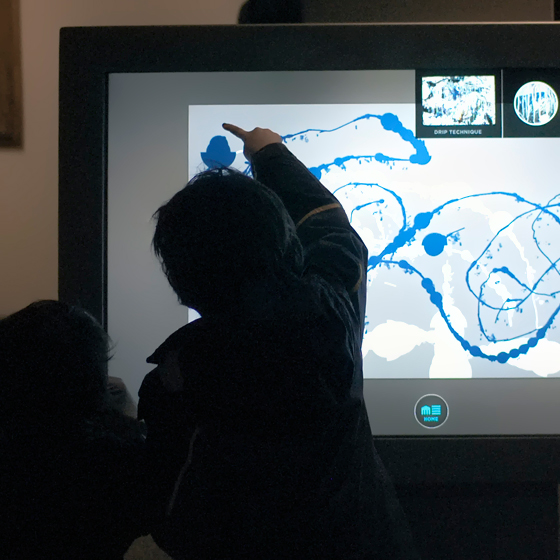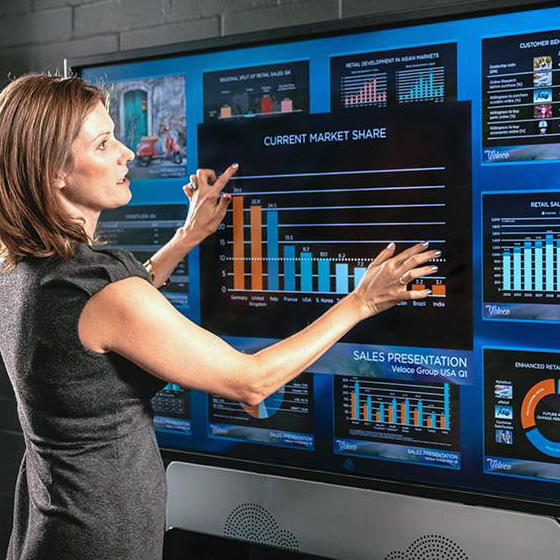TOUCH SCREEN TECHNOLOGIES

Resistive Touch Screen Technology
Resistive technology is versatile and economical for applications such as food service and retail point of sale, industrial process control and instrumentation, portable and handheld products and communication devices.
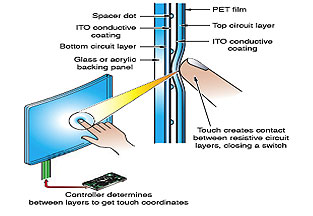
Resistive touch screens have a flexible top layer and a rigid bottom layer separated by insulating dots, with the inside surface of each layer coated with a transparent conductive coating.
Voltage applied to the layers produces a gradient across each layer. Pressing the flexible top sheet creates electrical contact between the resistive layers, essentially closing a switch in the circuit.
- Value solution
- Activated by any stylus
- High touch point resolution
- Low power requirements
- Reduced optical clarity
- Polyester surface can be damaged
Projected Capacitive (Multi-touch) Technology
Projected capacitive technology offers durability, reliability, and optical clarity. Popular applications include gaming machines, ATM installations, kiosks, industrial equipment, and point-of-sale.

Projected capacitive technologies detect touch by measuring the capacitance at each addressable electrode. When a finger or a conductive stylus approaches an electrode, it disturbs the electromagnetic field and alters the capacitance. This change in capacitance can be measured by the electronics and then converted into X,Y locations that the system can use to detect touch.
3M Project Capacitive Technology (3M PCT) is based on mutual capacitance to create multi-touch interactive. Mutual capacitance is the intentional or unintentional capacitance between two "charge holding objects” (see illustration). Projected capacitance touchscreens intentionally create mutual capacitance between elements of columns and rows in the vicinity where each intersect the other. This allows the system electronics to measure each node (intersection) individually to detect multiple touches on the screen during one screen scan.
When a finger touches near an intersection, some of the mutual capacitance between the row and column is coupled to the finger which reduce the capacitance at the intersection as measured by the system electronics. This reduced capacitance crosses the "touch threshold" set by the electronics indicating a touch has occurred.
- Extremely durable
- Very accurate
- Good optical clarity
- Good resolution
- Requires bare finger or capacitive stylus
- Severe scratch can affect operation within the damaged area
Dispersive (DST) Touch Screen Technology
Dispersive Signal Technology (DST) consists of a chemically-strengthened glass substrate with piezos mounted on each corner, mated to a sophisticated, dedicated controller.

The DST Touch System determines the touch position by pinpointing the source of "bending waves" created by finger or stylus contact within the glass substrate. This process of interpreting bending waves within the glass substrate helps eliminate traditional performance issues related to on-screen contaminants and surface damage, and provides fast, accurate touch attributes.
- Fast, accurate repeatable touch
- Touch operates with static objects or other touches on the screen
- Touch unaffected by surface contaminants, such as dirt, dust and grime
- Excellent light transmission provides vibrant optical characteristics with anti-glare properties
- Operation unaffected by surface damage
- Input flexibility from finger or stylus, such as pencil, credit card, fingernail, or almost any pointing stylus
- Available for display sizes 32" to 46"
- More expensive to integrate than Optical
- Only available for displays 32" and larger
Acoustic Wave Touch Screen Technology (SAW)
Because of its high optical clarity and accuracy, acoustic wave technology is typically used in kiosk applications.

Acoustic wave touch screens use transducers mounted at the edge of a glass overlay to emit ultrasonic sound waves along two sides. These waves are reflected across the surface of the glass and received by sensors. A finger or other soft tipped stylus absorbs some of the acoustic energy and the controller measures the amplitude change of the wave to determine touch location.
- Good optical clarity
- Z-axis capability
- Durable glass front
- Requires finger or sound absorbing stylus
- Difficult to industrialize
- Signal affected by surface liquids or other contaminants
Infrared Touch Screen Technology
Infrared touch screens are primarily used for large displays, banking machines, and in military applications.
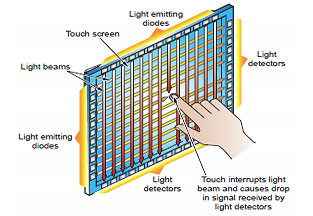
Infrared touch screens are based on light-beam interruption technology. Instead of an overlay on the surface, a frame surrounds the display. The frame has light sources, or light emitting diodes (LEDs) on one side and light detectors on the opposite side, creating an optical grid across the screen.
When an object touches the screen, the invisible light beam is interrupted, causing a drop in the signal received by the photo sensors.
- 100% light transmission (not an overlay)
- Accurate
- Costly
- Low reliability (MTBF for diodes)
- Parallax problems
- Accidental activation
- Low touch resolution
- No protection for display surface
Optical Touch Screen Technology
Optical touch screen technology is ideal for large LCD and plasma displays up to 100" diagonal.

Optical touch screen technology uses two line scanning cameras located at the corners of the screen. The cameras track the movement of any object close to the surface by detecting the interruption of an infra-red light source. The light is emitted in a plane across the surface of the screen and can be either active (infra-red LED) or passive (special reflective surfaces).
- 100% light transmission (not an overlay)
- Accurate
- Can be retro-fitted to any existing large format LCD or Plasma display
- Can be used with finger, gloved hand or stylus
- Requires only one calibration
- Plug and play - no software drivers
- Can be affected by direct sunlight
- Frame increases overall depth of monitor
- Cannot be fitted to plasma and LCD displays with integrated speakers
What is multi-touch?
The term "multi-touch" is now in common use to describe any touch screen that can recognise more than one point of contact, in effect the use of two or more fingers simultaneously.
Single Touch
Single Touch occurs when a finger or stylus creates a touch event on the surface of a touch sensor or within a touch field so it is detected by the touch controller and the application can determine the X,Y coordinates of the touch event.

Single Touch occurs when a finger or stylus creates a touch event on the surface of a touch sensor or within a touch field so it is detected by the touch controller and the application can determine the X,Y coordinates of the touch event.
These technologies have been integrated into millions of devices and typically do not have the ability to detect or resolve more than a single touch point at a time as part of their standard configuration.
Single Touch with Pen Input
Single Touch with Pen input functionality can range from a simple, inactive pointer or stylus to complex, active tethered pens.

Inactive pens enable the same input characteristics as a finger, but with greater pointing accuracy, while sophisticated, active pens can provide more control and uses for the touch system with drawing and palm rejection capabilities, and mouse event capabilities.
Single Touch with Gesture
Enhancements to firmware, software and hardware by many single touch technologies have increased their touch functionality. Some touch technologies can use advanced processing capabilities to "detect" or recognize that a second touch event is occurring, which is called a "gesture event".

Since single touch systems can´t resolve the exact location of the second touch event, they rely on algorithms to interpret or anticipate the intended gesture event input. Common industry terms for this functionality are two-finger gestures, dual touch, dual control, and gesture touch.
Two Touch (2-point)
Two Touch refers to a touch system that can detect and resolve two discrete, simultaneous touch events.

The best demonstration of Two Touch capability is to draw two parallel lines on the screen at the same time. Two Touch systems can also support gesturing.
Multi-touch
Multi-touch refers to a touch system´s ability to simultaneously detect and resolve a minimum of 3+ touch points. All 3 or more touches are detected and fully resolved resulting in a dramatically improved touch experience.

Multi-touch is considered by many to become a widely-used interface mainly because of the speed, efficiency and intuitiveness of the technology.
